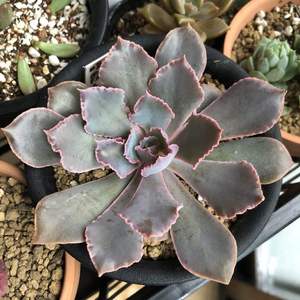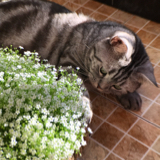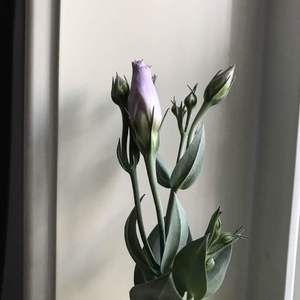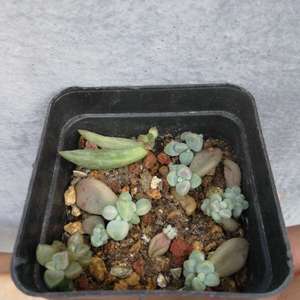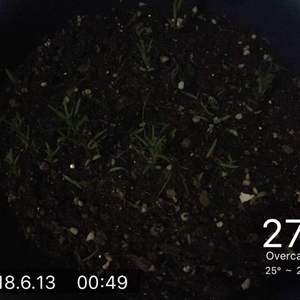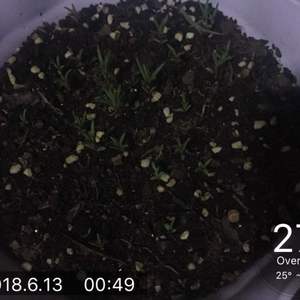文章
Miss Chen
2018年06月14日

Description: This wildflower is a biennial that forms a rosette of basal leaves during the first year, followed by a flowering plant about 2-7' tall the following year. The basal leaves are up to 16" long and 6" across, although they are normally closer to about one-half that size. Aside from a tendency to be larger in size, they are similar to the alternate leaves of a flowering plant (as described below). A typical flowering plant is unbranched below and occasionally branched above. The central stem and any lateral stems are light green, terete, and longitudinally furrowed; they are finely hairy above, becoming more glabrous below. Alternate leaves are up to 10" long and 4" across, becoming gradually smaller in size as they ascend the stems. In outline, these leaves are lanceolate-oblong to elliptic-oblong; they are also pinnatifid with several pairs of lanceolate to linear-lanceolate lobes that have spiny tips. The lobes of the alternate leaves usually have smaller secondary lobes or sharp teeth that may also have spiny tips. The spines are golden yellow and up to 1/8" (3 mm.) long. The upper leaf surface is medium to dark green and glabrous to sparsely short-pubescent. The lower leaf surface is usually whitened from a dense coating of short white hairs while young, but it becomes more pale green with age from a thinning of such hairs.

The central stem and any upper stems terminate in either individual flowerheads or open corymbs of 2-5 flowerheads. The peduncles of these flowerhead are 1-6" long, light green (less often pale purple), terete, finely grooved, and finely hairy to nearly glabrous. There is usually a single leafy bract (up to 3" long) at the base of each peduncle and, less often, there may be a whorl of a few leafy bracts (up to 1½" long) underneath the flowerhead. Otherwise, the peduncle is naked. The leafy bracts resemble the alternate leaves, except they are smaller in size and their spiny lobes are more narrow. Each peduncle terminates in a flowerhead that is about 1¼-2" across and similarly in length. At the flattened top of the flowerhead, there is a dense cluster of numerous disk florets; there are no ray florets. The disk florets are perfect and fertile. The corollas of the disk florets are narrowly cylindrical below, becoming slightly wider above with 5 narrow lobes. These corollas vary in color from pink to pinkish purple. The sides of the flowerhead consist of overlapping floral bracts (phyllaries) that are appressed together in several series. These floral bracts are lanceolate to ovate in shape; their tips taper into erect minute spines, or such spines may be absent. The sticky floral bracts have narrow mid-ribs that are pale green, otherwise they are blackish green; appressed woolly hair usually occurs between the floral bracts. The blooming period occurs from mid-summer to early fall, lasting about 1½ months. Afterwards, the ray florets are replaced by small achenes with tufts of white hair. Individual achenes are about 5 mm. long, oblongoid, and dark brown to black with bands of yellow at their upper ends. They are distributed by the wind. The root system consists of a stout taproot.

Cultivation: The preference is full sun, wet to moist conditions, and calcareous sand, although partial sun and other soil types are tolerated. The size of individual plants can be highly variable, depending on moisture level, soil fertility, and competition from other plants.
Range & Habitat: The native Swamp Thistle is occasional in NE Illinois, otherwise it is uncommon or absent elsewhere in the state (see Distribution Map). This plant is more common further to the north. Habitats include wet sand prairies, sandy swamps, marshes, fens, interdunal swales near Lake Michigan, limestone bluffs (where some seepage of ground water occurs), pastures, and abandoned sandy fields. Swamp Thistle is found primarily in sandy wetlands and rocky areas where seepage through limestone occurs. It is perhaps most common in fens.
Faunal Associations: The flowerheads of Swamp Thistle and similar Cirsium spp. (thistles) attract many insects, especially long-tongued bees and butterflies. Typical floral visitors include honeybees, bumblebees, long-horned bees (Melissodes spp.), leaf-cutting bees (Megachile spp.), Cuckoo beesTiger Swallowtail Nectaring at Flowerhead (Triepeolus spp.), Swallowtail butterflies (Papilio spp.), Fritillary butterflies (Speyeria spp.), Painted Lady butterflies (Vanessa spp.), and day-flying moths. Most of these insects suck nectar, although some bees also collect pollen. A long-horned bee, Melissodes desponsa, is an oligolege (specialist pollinator) of thistles. Other insect feed destructively on these plants. Swamp Thistle is the preferred host plant for the caterpillars of an uncommon butterfly, Calephelis mutica (Swamp Metalmark). Other insect feeders of thistles include caterpillars of Vanessa cardui (Painted Lady), caterpillars of Platyptilia carduidactyla (Artichoke Plume Moth) and Papaipema arctivorens (Northern Burdock Borer Moth), the leaf beetle Cassida rubiginosa, stem-boring larvae of Lixus concavus (Rhubarb Weevil), Melanoplus borealis (Northern Grasshopper), Brachycaudus cardui (Thistle Aphid) and Capitophorus elaeagni (Artichoke Aphid), and the treehopper Entylia bactriana. See the Insect Table for a more complete listing of these species. Because Swamp Thistle has some protection from its spines and it occurs in less accessible wetland habitats, it is usually ignored by mammalian herbivores. Some small songbirds, however, eat the seeds of thistles, especially the American Goldfinch. This bird also uses the hair tufts of thistle seeds in the construction of its nests. Another small bird, the Ruby-Throated Hummingbird, occasionally visits the flowerheads of thistles for their nectar.
Photographic Location: A fen in NE Illinois. The photographs were taken by Lisa Culp (Copyright © 2011).
Comments: Swamp Thistle (Cirsium muticum) resembles the more common Pasture Thistle (Cirsium discolor) and other tall-growing thistle species. It can be distinguished from these other species by the lack of significant spines on its floral bracts (phyllaries) and its preference for wetland habitats. While the leaf undersides of Swamp Thistle tend to be somewhat whitened, they are usually less whitened than either the Pasture Thistle or Tall Thistle (Cirsium altissimum). A Eurasian species that has not been found in Illinois, but appears to be spreading in other areas of the United States, is the Marsh Thistle (Cirsium palustre). Like the Swamp Thistle, Marsh Thistle also prefers wetland habitats, but it has smaller flowerheads (1" across or less) and its floral bracts have outward-pointing fine spines. This Eurasian thistle also tends to be somewhat smaller in size than the Swamp Thistle. Another common name of Cirsium muticum is Fen Thistle.

The central stem and any upper stems terminate in either individual flowerheads or open corymbs of 2-5 flowerheads. The peduncles of these flowerhead are 1-6" long, light green (less often pale purple), terete, finely grooved, and finely hairy to nearly glabrous. There is usually a single leafy bract (up to 3" long) at the base of each peduncle and, less often, there may be a whorl of a few leafy bracts (up to 1½" long) underneath the flowerhead. Otherwise, the peduncle is naked. The leafy bracts resemble the alternate leaves, except they are smaller in size and their spiny lobes are more narrow. Each peduncle terminates in a flowerhead that is about 1¼-2" across and similarly in length. At the flattened top of the flowerhead, there is a dense cluster of numerous disk florets; there are no ray florets. The disk florets are perfect and fertile. The corollas of the disk florets are narrowly cylindrical below, becoming slightly wider above with 5 narrow lobes. These corollas vary in color from pink to pinkish purple. The sides of the flowerhead consist of overlapping floral bracts (phyllaries) that are appressed together in several series. These floral bracts are lanceolate to ovate in shape; their tips taper into erect minute spines, or such spines may be absent. The sticky floral bracts have narrow mid-ribs that are pale green, otherwise they are blackish green; appressed woolly hair usually occurs between the floral bracts. The blooming period occurs from mid-summer to early fall, lasting about 1½ months. Afterwards, the ray florets are replaced by small achenes with tufts of white hair. Individual achenes are about 5 mm. long, oblongoid, and dark brown to black with bands of yellow at their upper ends. They are distributed by the wind. The root system consists of a stout taproot.

Cultivation: The preference is full sun, wet to moist conditions, and calcareous sand, although partial sun and other soil types are tolerated. The size of individual plants can be highly variable, depending on moisture level, soil fertility, and competition from other plants.
Range & Habitat: The native Swamp Thistle is occasional in NE Illinois, otherwise it is uncommon or absent elsewhere in the state (see Distribution Map). This plant is more common further to the north. Habitats include wet sand prairies, sandy swamps, marshes, fens, interdunal swales near Lake Michigan, limestone bluffs (where some seepage of ground water occurs), pastures, and abandoned sandy fields. Swamp Thistle is found primarily in sandy wetlands and rocky areas where seepage through limestone occurs. It is perhaps most common in fens.
Faunal Associations: The flowerheads of Swamp Thistle and similar Cirsium spp. (thistles) attract many insects, especially long-tongued bees and butterflies. Typical floral visitors include honeybees, bumblebees, long-horned bees (Melissodes spp.), leaf-cutting bees (Megachile spp.), Cuckoo beesTiger Swallowtail Nectaring at Flowerhead (Triepeolus spp.), Swallowtail butterflies (Papilio spp.), Fritillary butterflies (Speyeria spp.), Painted Lady butterflies (Vanessa spp.), and day-flying moths. Most of these insects suck nectar, although some bees also collect pollen. A long-horned bee, Melissodes desponsa, is an oligolege (specialist pollinator) of thistles. Other insect feed destructively on these plants. Swamp Thistle is the preferred host plant for the caterpillars of an uncommon butterfly, Calephelis mutica (Swamp Metalmark). Other insect feeders of thistles include caterpillars of Vanessa cardui (Painted Lady), caterpillars of Platyptilia carduidactyla (Artichoke Plume Moth) and Papaipema arctivorens (Northern Burdock Borer Moth), the leaf beetle Cassida rubiginosa, stem-boring larvae of Lixus concavus (Rhubarb Weevil), Melanoplus borealis (Northern Grasshopper), Brachycaudus cardui (Thistle Aphid) and Capitophorus elaeagni (Artichoke Aphid), and the treehopper Entylia bactriana. See the Insect Table for a more complete listing of these species. Because Swamp Thistle has some protection from its spines and it occurs in less accessible wetland habitats, it is usually ignored by mammalian herbivores. Some small songbirds, however, eat the seeds of thistles, especially the American Goldfinch. This bird also uses the hair tufts of thistle seeds in the construction of its nests. Another small bird, the Ruby-Throated Hummingbird, occasionally visits the flowerheads of thistles for their nectar.
Photographic Location: A fen in NE Illinois. The photographs were taken by Lisa Culp (Copyright © 2011).
Comments: Swamp Thistle (Cirsium muticum) resembles the more common Pasture Thistle (Cirsium discolor) and other tall-growing thistle species. It can be distinguished from these other species by the lack of significant spines on its floral bracts (phyllaries) and its preference for wetland habitats. While the leaf undersides of Swamp Thistle tend to be somewhat whitened, they are usually less whitened than either the Pasture Thistle or Tall Thistle (Cirsium altissimum). A Eurasian species that has not been found in Illinois, but appears to be spreading in other areas of the United States, is the Marsh Thistle (Cirsium palustre). Like the Swamp Thistle, Marsh Thistle also prefers wetland habitats, but it has smaller flowerheads (1" across or less) and its floral bracts have outward-pointing fine spines. This Eurasian thistle also tends to be somewhat smaller in size than the Swamp Thistle. Another common name of Cirsium muticum is Fen Thistle.
0
0
文章
Miss Chen
2018年06月14日

Description: This biennial or short-lived perennial plant is 3-6' tall, branching occasionally. The stout stems are terete, glabrous, and sometimes glaucous; they are pale green, pink, or reddish purple, often with prominent longitudinal veins. The lower portion of the central stem is hollow. The compound leaves are odd-pinnate or doubly odd-pinnate; they alternate along the stems. The lower compound leaves are up to 1½' long and ¾' across; the upper compound leaves are much smaller. Each division of a compound leaf typically has 3-7 leaflets. The bases of petioles are partially enclosed by their sheaths; otherwise they are similar to the stems in appearance, although more slender. The glabrous leaflets are 1½-4" long and ½-1¼" across; they are oblong-elliptic with wedge-shaped bottoms, tapered tips, and dentate margins. Sometimes the leaflets fold upward along the length of their central veins. Leaflet venation is pinnate. The lateral veins of leaflets extend to the notches between the teeth, rather than to their tips, along the leaflet margins.
The upper stems occasionally produce compound umbels of small white flowers. These compound umbels are up to 6" across and consist of 10-20 umbellets. Individual umbels are dome-shaped on top, rather than flat. Individual umbellets have about 12-15 flowers that are clustered together. Each flower is about 1/8" across, consisting of 5 white petals, an insignificant calyx, 5 white stamens, and a divided style. The tiny petals are constricted at their bases, and they have notched tips. The blooming period occurs during mid-summer, lasting about 1 month. The flowers have a slight fragrance that is sometimes detectable. Afterwards, each flower is replaced by a small angular fruit containing a pair of seeds. The root system consists of several fleshy roots at the base of the plant; they are ovoid or oblongoid in shape. These fleshy roots are exceptionally poisonous; the stems and foliage are somewhat less poisonous. This plant spreads by reseeding itself into neighboring areas.
Cultivation: The preference is full to partial sun and wet to moist conditions. Some standing water is tolerated, if it is temporary. Either loamy or sandy soil is acceptable to this plant; it should contain some organic material to retain moisture. Foliar disease isn't a significant problem for healthy plants in an appropriate location.

Range & Habitat: The native Water Hemlock has been observed in nearly all counties of Illinois (see Distribution Map); it is occasional to locally common. Habitats include moist open woodlands, swamps, wet prairies, prairie swales, marshes, seeps, and roadside ditches. Water Hemlock prefers moister locations than the introduced Conium maculatum (Poison Hemlock), and so these two species rarely compete with each other for the same ecological niche. It is not uncommon to find Water Hemlock growing where Iris virginica shrevei (Blue Flag Iris) also occurs.
Faunal Associations: The exposed nectar of the flowers attract primarily insects with short mouthparts. These floral visitors include leafcutter bees (Megachile spp.), Halictid bees, cuckoo bees (Sphecodes spp.), plasterer bees (Colletes spp.), masked bees (Hylaeus spp.), Sphecid wasps, Vespid wasps, Tiphiid wasps, spider wasps (Pompilidae), velvet ants (Mutillidae), cuckoo wasps (Chrysididae), Eucoilid wasps, Braconid wasps, soldier flies (Stratiomyidae), Syrphid flies, thick-headed flies (Conopidae), Tachinid flies, flesh flies (Sarcophagidae), Muscid flies, and miscellaneous beetles (Robertson, 1929). The larvae of a butterfly, Papilio polyxenes (Black Swallowtail), feed on the foliage of Water Hemlock, while the larvae of a moth, Epermenia cicutaella, feed on the flowers and immature fruits. Several aphids suck plant juices from this plant, including Cavariella aegopodii (Carrot-Willow Aphid), Cavariella pastinacae (Parsnip-Willow Aphid), and Hyadaphis foeniculi (Honeysuckle-Fennel Aphid). Other insect feeders include Apion pensylvanicum (a weevil), Orthops scutellatus (Carrot Plant Bug), Paroxyna atlantica (Atlantic Grasshopper), and Paroxyna clavuliger (Olive-Green Swamp Grasshopper); see Pepper (1965), Blackman & Eastop (2013), Majka et al. (2007), Wheeler et al. (1983), and Harms & Grodowitz (2009). The toxic foliage and roots are usually left undisturbed by mammalian herbivores, although cattle and other livestock sometimes eat this plant with dire results. The fleshy roots are especially toxic: just a small piece can be fatal.

Photographic Location: The photographs were taken of plants in a wet prairie along an abandoned railroad in Champaign County, Illinois. There was 2 ft. of standing water around the base of the plants as the result of a recent heavy rainfall, although at other times the site is merely moist.
Comments: Water Hemlock is a reasonably attractive and eloquent plant, while the flowers provide nectar to many beneficial insects. It is fairly easy to distinguish Water Hemlock from other members of the Carrot family because of its double compound leaves and rather large leaflets that are rarely lobed. Many other members of the Carrot family have only simple compound leaves, or their leaflets are much smaller in size, or their leaflets are deeply lobed. On Water Hemlock, the lateral veins of the leaflets extend to the notches between the teeth, rather than to their tips, along the leaf margins. Apparently, no other member of the Carrot family in Illinois has this characteristic.
The upper stems occasionally produce compound umbels of small white flowers. These compound umbels are up to 6" across and consist of 10-20 umbellets. Individual umbels are dome-shaped on top, rather than flat. Individual umbellets have about 12-15 flowers that are clustered together. Each flower is about 1/8" across, consisting of 5 white petals, an insignificant calyx, 5 white stamens, and a divided style. The tiny petals are constricted at their bases, and they have notched tips. The blooming period occurs during mid-summer, lasting about 1 month. The flowers have a slight fragrance that is sometimes detectable. Afterwards, each flower is replaced by a small angular fruit containing a pair of seeds. The root system consists of several fleshy roots at the base of the plant; they are ovoid or oblongoid in shape. These fleshy roots are exceptionally poisonous; the stems and foliage are somewhat less poisonous. This plant spreads by reseeding itself into neighboring areas.
Cultivation: The preference is full to partial sun and wet to moist conditions. Some standing water is tolerated, if it is temporary. Either loamy or sandy soil is acceptable to this plant; it should contain some organic material to retain moisture. Foliar disease isn't a significant problem for healthy plants in an appropriate location.

Range & Habitat: The native Water Hemlock has been observed in nearly all counties of Illinois (see Distribution Map); it is occasional to locally common. Habitats include moist open woodlands, swamps, wet prairies, prairie swales, marshes, seeps, and roadside ditches. Water Hemlock prefers moister locations than the introduced Conium maculatum (Poison Hemlock), and so these two species rarely compete with each other for the same ecological niche. It is not uncommon to find Water Hemlock growing where Iris virginica shrevei (Blue Flag Iris) also occurs.
Faunal Associations: The exposed nectar of the flowers attract primarily insects with short mouthparts. These floral visitors include leafcutter bees (Megachile spp.), Halictid bees, cuckoo bees (Sphecodes spp.), plasterer bees (Colletes spp.), masked bees (Hylaeus spp.), Sphecid wasps, Vespid wasps, Tiphiid wasps, spider wasps (Pompilidae), velvet ants (Mutillidae), cuckoo wasps (Chrysididae), Eucoilid wasps, Braconid wasps, soldier flies (Stratiomyidae), Syrphid flies, thick-headed flies (Conopidae), Tachinid flies, flesh flies (Sarcophagidae), Muscid flies, and miscellaneous beetles (Robertson, 1929). The larvae of a butterfly, Papilio polyxenes (Black Swallowtail), feed on the foliage of Water Hemlock, while the larvae of a moth, Epermenia cicutaella, feed on the flowers and immature fruits. Several aphids suck plant juices from this plant, including Cavariella aegopodii (Carrot-Willow Aphid), Cavariella pastinacae (Parsnip-Willow Aphid), and Hyadaphis foeniculi (Honeysuckle-Fennel Aphid). Other insect feeders include Apion pensylvanicum (a weevil), Orthops scutellatus (Carrot Plant Bug), Paroxyna atlantica (Atlantic Grasshopper), and Paroxyna clavuliger (Olive-Green Swamp Grasshopper); see Pepper (1965), Blackman & Eastop (2013), Majka et al. (2007), Wheeler et al. (1983), and Harms & Grodowitz (2009). The toxic foliage and roots are usually left undisturbed by mammalian herbivores, although cattle and other livestock sometimes eat this plant with dire results. The fleshy roots are especially toxic: just a small piece can be fatal.

Photographic Location: The photographs were taken of plants in a wet prairie along an abandoned railroad in Champaign County, Illinois. There was 2 ft. of standing water around the base of the plants as the result of a recent heavy rainfall, although at other times the site is merely moist.
Comments: Water Hemlock is a reasonably attractive and eloquent plant, while the flowers provide nectar to many beneficial insects. It is fairly easy to distinguish Water Hemlock from other members of the Carrot family because of its double compound leaves and rather large leaflets that are rarely lobed. Many other members of the Carrot family have only simple compound leaves, or their leaflets are much smaller in size, or their leaflets are deeply lobed. On Water Hemlock, the lateral veins of the leaflets extend to the notches between the teeth, rather than to their tips, along the leaf margins. Apparently, no other member of the Carrot family in Illinois has this characteristic.
0
0
求助
胡小林
2018年06月13日

5月18日到6月14日的变化。是否在徒长?该怎么调整?请行家指点!
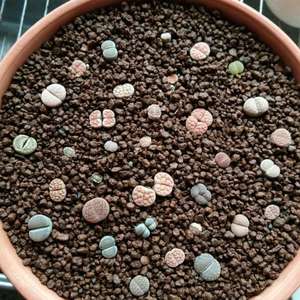
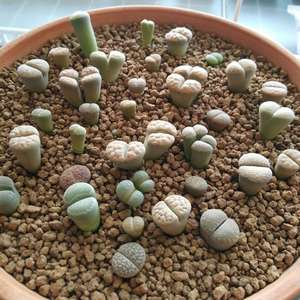


0
0
胡小林:@Fion:光照时长不足,加补光灯吧。谢谢你的指点!
Fion:徒了,减少浇水,拉长浇水间隔,保持每天至少3小时日照。只能不让继续徒,没办法变回原来的样子的啊,这是个人经验,你可以尝试看看
文章
Miss Chen
2018年06月11日

Description: This perennial plant is about 3-5' tall, branching frequently in the upper half. The green stems are glabrous, terete, and slightly ribbed. The alternate leaves are up to 6" long and ¾" across, becoming smaller and more narrow as they ascend the stems. They are narrowly lanceolate to oblanceolate, smooth along their margins, and glabrous; the uppermost leaves are linear. Each leaf tapers gradually to a short petiole-like base. The upper stems terminate in showy panicles of flowerheads; these flowerheads are produced in abundance. Each daisy-like flowerhead is about ¾" across, consisting of about 60 ray florets that surround numerous disk florets. The petaloid rays of the flowerheads are bright white and linear in shape (less often, they are slightly pink or slightly purple), while the tiny tubular corollas of the disk florets are bright yellow. Flowerheads have bases that are shallow and spreading, rather than cylindrically shaped; these bases are covered with overlapping floral bracts (phyllaries) that are light green and narrowly lanceolate in shape. The branching stalks of the panicle are similar to the stems and largely naked, except for narrow leaf-like bracts up to 1" long.
The blooming period occurs from late summer into the fall and lasts about 1 month. The florets are replaced by oblongoid achenes that are somewhat flattened; they are slightly broader at their apices than their bottoms. The apex of each achene has minute scales and a pair of bristles, although the bristles are not always present. The achenes usually fall only a short distance from the mother plant, unless they are carried about by water. The root system sometimes produces stolons that form plantlets at their tips.
Cultivation: The preference is partial or full sun, wet to moist conditions, and a fertile loamy soil. This plant can tolerate standing water for short periods of time and doesn't seem to be bothered by foliar disease to the same extent as many Aster spp. (Asters).

Range & Habitat: The native False Aster occurs occasionally in most areas of Illinois; it is slightly more common in southern Illinois than other areas of the state (see Distribution Map). Habitats include openings in floodplain forests, soggy thickets, alluvial meadows, prairie swales, marshes, and ditches.
Faunal Associations: The flowerheads attract many kinds of insects because their nectar and pollen are readily accessible. These insect visitors include long-tongued bees, short-tongued bees, wasps, flies, butterflies, skippers, moths, and beetles. A dagger bee, Perdita boltoniae, is an oligolege of Boltonia spp. Another bee that is somewhat oligolectic of these species is the long-horned bee, Melissodes boltoniae, which also visits the flowerheads of some Aster spp. False Aster is one of the host plants of a beetle, Microrhopala xerene, whose larvae mine the leaves. The ecological relationships of Boltonia spp. to vertebrate animals are probably similar to those of Aster spp. in wetland areas.

Photographic Location: A prairie swale at Meadowbrook Park in Urbana, Illinois.
Comments: False Aster has attractive foliage and flowers. Different varieties of False Aster have been described; the one that is typically encountered in the state, var. recognita, has flowerheads about ¾" across. In Cook County, var. microcephala also occurs, which has flowerheads that are ½" across or less. While Boltonia spp. (false asters) closely resemble Aster spp. (asters) in appearance, they differ from each other in the following characteristic: The achenes of false asters have minutes scales and/or a pair of bristles at their apices, while the achenes of asters have tufts of hair. As a result, the achenes of asters are carried more readily by the wind into new areas. The other false asters in Illinois are uncommon and differ from Boltonia asteroides by their leaves: Boltonia diffusa interior has linear leaves throughout, while Boltonia decurrens has leaves that are decurrent against their stems (i.e., the base or basal margins of each leaf lies along the surface of the stem).
The blooming period occurs from late summer into the fall and lasts about 1 month. The florets are replaced by oblongoid achenes that are somewhat flattened; they are slightly broader at their apices than their bottoms. The apex of each achene has minute scales and a pair of bristles, although the bristles are not always present. The achenes usually fall only a short distance from the mother plant, unless they are carried about by water. The root system sometimes produces stolons that form plantlets at their tips.
Cultivation: The preference is partial or full sun, wet to moist conditions, and a fertile loamy soil. This plant can tolerate standing water for short periods of time and doesn't seem to be bothered by foliar disease to the same extent as many Aster spp. (Asters).

Range & Habitat: The native False Aster occurs occasionally in most areas of Illinois; it is slightly more common in southern Illinois than other areas of the state (see Distribution Map). Habitats include openings in floodplain forests, soggy thickets, alluvial meadows, prairie swales, marshes, and ditches.
Faunal Associations: The flowerheads attract many kinds of insects because their nectar and pollen are readily accessible. These insect visitors include long-tongued bees, short-tongued bees, wasps, flies, butterflies, skippers, moths, and beetles. A dagger bee, Perdita boltoniae, is an oligolege of Boltonia spp. Another bee that is somewhat oligolectic of these species is the long-horned bee, Melissodes boltoniae, which also visits the flowerheads of some Aster spp. False Aster is one of the host plants of a beetle, Microrhopala xerene, whose larvae mine the leaves. The ecological relationships of Boltonia spp. to vertebrate animals are probably similar to those of Aster spp. in wetland areas.

Photographic Location: A prairie swale at Meadowbrook Park in Urbana, Illinois.
Comments: False Aster has attractive foliage and flowers. Different varieties of False Aster have been described; the one that is typically encountered in the state, var. recognita, has flowerheads about ¾" across. In Cook County, var. microcephala also occurs, which has flowerheads that are ½" across or less. While Boltonia spp. (false asters) closely resemble Aster spp. (asters) in appearance, they differ from each other in the following characteristic: The achenes of false asters have minutes scales and/or a pair of bristles at their apices, while the achenes of asters have tufts of hair. As a result, the achenes of asters are carried more readily by the wind into new areas. The other false asters in Illinois are uncommon and differ from Boltonia asteroides by their leaves: Boltonia diffusa interior has linear leaves throughout, while Boltonia decurrens has leaves that are decurrent against their stems (i.e., the base or basal margins of each leaf lies along the surface of the stem).
0
0
成长记
Koala小熊
2018年06月10日

不知不覺接觸多肉植物也滿一年了
去年的6/9把小熊童子帶回來養
中間經過修剪和移盆
現在已經長這麼大了
希望可以平安度過這個夏天
熊童子 生日快樂唷~~~(^^)
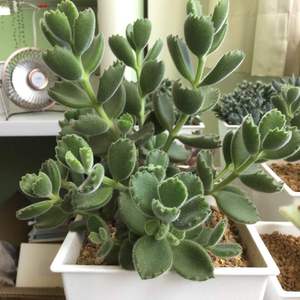
去年的6/9把小熊童子帶回來養
中間經過修剪和移盆
現在已經長這麼大了
希望可以平安度過這個夏天
熊童子 生日快樂唷~~~(^^)

2
0
新手琪琪😊:你種得很美,不知道為甚麼我的又瘦又扁哦😞
文章
Miss Chen
2018年06月10日

Description: This perennial wildflower is consists of a low rosette of basal leaves spanning about 6" across, from which one or more flowering stalks develop. The basal leaves are up to 3½" long and 3½" across; they are ovate-cordate, cordate, to nearly orbicular in shape and their margins are crenate-serrate. Leaf bases are indented, while leaf tips are rounded to bluntly pointed. The upper leaf surface is medium green and glabrous, while the lower surface is pale-medium green and glabrous (or nearly so). Leaf venation is mostly palmate. The petioles are up to 4" long, light green, and glabrous.
Solitary flowers are produced at the tips of pedicels up to 7" long. The erect to ascending pedicels are light green to light purplish green and glabrous. Each flower is about ¾" across, consisting of 5 medium to dark blue-violet petals (rarely white), 5 light green sepals, and the reproductive organs. The petals are elliptic-obovate in shape and about twice the length of the sepals. The 2 lateral petals have short white hairs with swollen tips near the throat of the flower. The lowermost petal has a patch of white with radiating purple veins in the front, while in the back it has a short stout nectar spur. The sepals are linear-lanceolate and glabrous; they usually have pointed auricles (eared basal lobes) up to 4 mm. long. The blooming period occurs from mid- to late spring for about 1 month. Afterwards, successfully fertilized flowers are replaced by seed capsules about ½" long that are light green and ovoid-oblongoid in shape. In addition to these flowers, cleistogamous (self-fertile) flowers are produced that lack showy petals. The cleistogamous flowers are produced on ascending pedicels during the summer. At maturity, the capsules of both types of flowers split open into 3 sections, to eject their seeds. Individual seeds are about 2.5 mm. in length, globoid in shape, and dark-colored. The root system consists of a crown with fibrous roots and rhizomes.

Cultivation: The preference is full sun to light shade, wet to moist conditions, and soil containing loam, silty loam, or sandy loam with organic matter.
Range & Habitat: The native Marsh Violet is occasional in NE Illinois, while the in the rest of the state it is uncommon or absent (see Distribution Map). Habitats include marshes, bogs, swamps, seeps, and borders of rocky streams. This violet is found in both sandy and non-sandy wetlands in both shaded and unshaded areas.

Faunal Associations: The floral nectar of Marsh Violet attracts bumblebees, mason bees (Osmia spp.), Halictid bees, Andrenid bees, bee flies (Bombyliidae), butterflies, and skippers (Robertson, 1929). Some of the bees also collect pollen. An oligolectic bee, Andrena violae, visits the flowers of Marsh Violet and other Viola spp. (violets). The caterpillars of several Fritillary butterflies feed on the foliage of violets primarily in open areas: Boloria bellona (Meadow Fritillary), Boloria selene myrina (Silver-Bordered Fritillary), Euptoieta claudia (Variegated Fritillary), Speyeria aphrodite (Aphrodite Fritillary), Speyeria atlantis (Atlantis Fritillary), Speyeria cybele (Great Spangled Fritillary), and Speyeria idalia (Regal Fritillary). Other insect feeders include caterpillars of the moths Elaphria grata (Grateful Midget) and Eubaphe mendica (The Beggar), the leaf-mining larvae of Ametastegia pallipes (Violet Sawfly), the aphid Neotoxoptera violae, and the thrips Odontothrips pictipennis. The seeds and other parts of violets are occasionally eaten by such birds as the Ruffed Grouse, Wild Turkey, and Mourning Dove, and they are also consumed by the White-Footed Mouse, Pine Mouse, and Eastern Chipmunk. Similarly, the foliage of these low-growing plants is a source of food for the Cottontail Rabbit and Wood Turtle (Clemmys insculpta).
Photographic Location: A sandy swamp at the Indiana Dunes State Park in NW Indiana.

Comments: At first glance, the Marsh Violet can be easily confused with the Common Blue Violet (Viola pratincola) and other rosette-forming violets (Viola spp.) with blue-violet flowers. It can be distinguished from these other species, however, by the club-shaped hairs on its lateral petals (a 10x hand lens may be required to see this). The hairs of lateral petals on other violets are usually filiform (thread-like) and rarely possess conspicuous swollen tips. The only other violet in Illinois that has such hairs on its lateral petals is the rare Wayside Violet (Viola viarum). This latter species is easily distinguished from the Marsh Violet by its lobed leaves and its preference for dry habitats. Across its range, the Marsh Violet is rather variable in such characteristics as the shade of blue-violet on its petals, the shape of its leaves, the presence or absence of pointed auricles (eared basal lobes) on its sepals, and the extent to which the flowers are held above the foliage. Although different varieties of the Marsh Violet have been described in other parts of North America, none of these are currently recognized in Illinois. The scientific name, Viola obliqua, is considered a synonym of this species.
Solitary flowers are produced at the tips of pedicels up to 7" long. The erect to ascending pedicels are light green to light purplish green and glabrous. Each flower is about ¾" across, consisting of 5 medium to dark blue-violet petals (rarely white), 5 light green sepals, and the reproductive organs. The petals are elliptic-obovate in shape and about twice the length of the sepals. The 2 lateral petals have short white hairs with swollen tips near the throat of the flower. The lowermost petal has a patch of white with radiating purple veins in the front, while in the back it has a short stout nectar spur. The sepals are linear-lanceolate and glabrous; they usually have pointed auricles (eared basal lobes) up to 4 mm. long. The blooming period occurs from mid- to late spring for about 1 month. Afterwards, successfully fertilized flowers are replaced by seed capsules about ½" long that are light green and ovoid-oblongoid in shape. In addition to these flowers, cleistogamous (self-fertile) flowers are produced that lack showy petals. The cleistogamous flowers are produced on ascending pedicels during the summer. At maturity, the capsules of both types of flowers split open into 3 sections, to eject their seeds. Individual seeds are about 2.5 mm. in length, globoid in shape, and dark-colored. The root system consists of a crown with fibrous roots and rhizomes.

Cultivation: The preference is full sun to light shade, wet to moist conditions, and soil containing loam, silty loam, or sandy loam with organic matter.
Range & Habitat: The native Marsh Violet is occasional in NE Illinois, while the in the rest of the state it is uncommon or absent (see Distribution Map). Habitats include marshes, bogs, swamps, seeps, and borders of rocky streams. This violet is found in both sandy and non-sandy wetlands in both shaded and unshaded areas.

Faunal Associations: The floral nectar of Marsh Violet attracts bumblebees, mason bees (Osmia spp.), Halictid bees, Andrenid bees, bee flies (Bombyliidae), butterflies, and skippers (Robertson, 1929). Some of the bees also collect pollen. An oligolectic bee, Andrena violae, visits the flowers of Marsh Violet and other Viola spp. (violets). The caterpillars of several Fritillary butterflies feed on the foliage of violets primarily in open areas: Boloria bellona (Meadow Fritillary), Boloria selene myrina (Silver-Bordered Fritillary), Euptoieta claudia (Variegated Fritillary), Speyeria aphrodite (Aphrodite Fritillary), Speyeria atlantis (Atlantis Fritillary), Speyeria cybele (Great Spangled Fritillary), and Speyeria idalia (Regal Fritillary). Other insect feeders include caterpillars of the moths Elaphria grata (Grateful Midget) and Eubaphe mendica (The Beggar), the leaf-mining larvae of Ametastegia pallipes (Violet Sawfly), the aphid Neotoxoptera violae, and the thrips Odontothrips pictipennis. The seeds and other parts of violets are occasionally eaten by such birds as the Ruffed Grouse, Wild Turkey, and Mourning Dove, and they are also consumed by the White-Footed Mouse, Pine Mouse, and Eastern Chipmunk. Similarly, the foliage of these low-growing plants is a source of food for the Cottontail Rabbit and Wood Turtle (Clemmys insculpta).
Photographic Location: A sandy swamp at the Indiana Dunes State Park in NW Indiana.

Comments: At first glance, the Marsh Violet can be easily confused with the Common Blue Violet (Viola pratincola) and other rosette-forming violets (Viola spp.) with blue-violet flowers. It can be distinguished from these other species, however, by the club-shaped hairs on its lateral petals (a 10x hand lens may be required to see this). The hairs of lateral petals on other violets are usually filiform (thread-like) and rarely possess conspicuous swollen tips. The only other violet in Illinois that has such hairs on its lateral petals is the rare Wayside Violet (Viola viarum). This latter species is easily distinguished from the Marsh Violet by its lobed leaves and its preference for dry habitats. Across its range, the Marsh Violet is rather variable in such characteristics as the shade of blue-violet on its petals, the shape of its leaves, the presence or absence of pointed auricles (eared basal lobes) on its sepals, and the extent to which the flowers are held above the foliage. Although different varieties of the Marsh Violet have been described in other parts of North America, none of these are currently recognized in Illinois. The scientific name, Viola obliqua, is considered a synonym of this species.
0
0
文章
Miss Chen
2018年06月10日

Description: This perennial wildflower forms a small rosette of ascending to erect basal leaves. Individual basal leaves are about 2-6" long and ¼-¾" across; their blades are narrowly lanceolate, lanceolate, narrowly elliptic, or elliptic in shape with crenate margins. The upper blade surface is medium green and hairless, while the lower surface is pale green and hairless to sparsely hairy. The leaf blades taper gradually into slender petioles; the latter are light green to reddish purple and hairless to sparsely hairy. Individual nodding flowers are produced from pedicels up to 6" long that originate from the rootstock. These pedicels are light green to reddish purple and hairless. The flowers span about ½" across (or a little more). Each flower has 5 spreading white petals, 5 light green sepals, and the reproductive organs. The lowermost petal has prominent purple veins, while the 2 lateral petals are purple-veined to a lesser extent. The petals are usually beardless (without prominent tufts of hair), although the lateral petals may have some residual hairs that are greenish white. The nectar spur of the lowermost petal is relatively short and stout. The sepals are linear-lanceolate and hairless; they are much shorter than the petals.

The blooming period occurs during late spring for about 3 weeks. Fertilized flowers are replaced by seed capsules about 1/3" long; these capsules are light green and ellipsoid-oblongoid in shape. Later in the summer, cleistogamous (self-fertile) flowers are produced from slender stolons. These cleistogamous flowers lack petals and remain inconspicuous. Each seed capsule eventually splits open into 3 parts, ejecting the small dark brown seeds. The root system consists of a short narrow crown with fibrous roots.
Cultivation: The preference is full sun, wet to moist conditions, and an acidic soil containing sand, gravel, or peat. Lance-Leaved Violet tolerates standing water to a greater extent than other violets.
Range & Habitat: The native Lance-Leaved Violet is occasional in northern Illinois, while in the rest of the state it is rare or absent (see Distribution Map). Habitats include wet to moist sand prairies, sandy swales, soggy shrub prairies, moist sandy savannas, bogs, gravelly areas along streams or lakes, and flood-prone areas of sandy paths. In Illinois, this violet is typically found in high quality natural areas where there is limited competition from other plants.Basal Leaves
Faunal Associations: The flowers of violets are visited by bumblebees, mason bees (Osmia spp.), long-horned bees (Synhalonia spp.), the Violet Andrenid bee (Andrena violae), the Giant bee-fly (Bombylius major), small butterflies, and skippers. These floral visitors seek nectar or pollen. Other insects feed on the foliage, plant juices, and other parts of violets. The caterpillars of several Fritillary butterflies feed on violets: Boloria bellona (Meadow Fritillary), Boloria selene myrina (Silver-Bordered Fritillary), Euptoieta claudia (Variegated Fritillary), Speyeria aphrodite (Aphrodite Fritillary), Speyeria atlantis (Atlantis Fritillary), Speyeria cybele (Great Spangled Fritillary), and Speyeria idalia (Regal Fritillary). Other insect feeders include caterpillars of the moths Elaphria grata (Grateful Midget) and Eubaphe mendica (The Beggar), Aulacorthum circumflexum (Crescent-Marked Lily Aphid) and Neotoxoptera violae (Violet Aphid), the larvae of Ametastegia pallipes (Viola Sawfly), and the thrips Odontothrips pictipennis. Among vertebrate animals, the seeds of violets are eaten by such birds as the Ruffed Grouse, Wild Turkey, Bobwhite, and Mourning Dove. The White-Footed Mouse and probably other small rodents also eat small amounts of the seeds. The foliage is browsed to a limited extent by the Cottontail Rabbit and Wood Turtle (Clemmys insculpta).
Photographic Location: Wet area of a sandy path that meandered through open shrub prairie at Kitty Todd Nature Preserve in NW Ohio.
Comments: This interesting violet has a distinctive appearance because of its narrow leaves. There are two subspecies of Lance-Leaved Violet: Viola lanceolata lanceolata (as photographed here) and Viola lanceolata vittata. The typical subspecies has leaf blades that are 3-5 times as long as they are across, while the latter subspecies has leaf blades that are 6-15 times as long as they are across. In Illinois, the typical subspecies is the more common of the two.

The blooming period occurs during late spring for about 3 weeks. Fertilized flowers are replaced by seed capsules about 1/3" long; these capsules are light green and ellipsoid-oblongoid in shape. Later in the summer, cleistogamous (self-fertile) flowers are produced from slender stolons. These cleistogamous flowers lack petals and remain inconspicuous. Each seed capsule eventually splits open into 3 parts, ejecting the small dark brown seeds. The root system consists of a short narrow crown with fibrous roots.
Cultivation: The preference is full sun, wet to moist conditions, and an acidic soil containing sand, gravel, or peat. Lance-Leaved Violet tolerates standing water to a greater extent than other violets.
Range & Habitat: The native Lance-Leaved Violet is occasional in northern Illinois, while in the rest of the state it is rare or absent (see Distribution Map). Habitats include wet to moist sand prairies, sandy swales, soggy shrub prairies, moist sandy savannas, bogs, gravelly areas along streams or lakes, and flood-prone areas of sandy paths. In Illinois, this violet is typically found in high quality natural areas where there is limited competition from other plants.Basal Leaves
Faunal Associations: The flowers of violets are visited by bumblebees, mason bees (Osmia spp.), long-horned bees (Synhalonia spp.), the Violet Andrenid bee (Andrena violae), the Giant bee-fly (Bombylius major), small butterflies, and skippers. These floral visitors seek nectar or pollen. Other insects feed on the foliage, plant juices, and other parts of violets. The caterpillars of several Fritillary butterflies feed on violets: Boloria bellona (Meadow Fritillary), Boloria selene myrina (Silver-Bordered Fritillary), Euptoieta claudia (Variegated Fritillary), Speyeria aphrodite (Aphrodite Fritillary), Speyeria atlantis (Atlantis Fritillary), Speyeria cybele (Great Spangled Fritillary), and Speyeria idalia (Regal Fritillary). Other insect feeders include caterpillars of the moths Elaphria grata (Grateful Midget) and Eubaphe mendica (The Beggar), Aulacorthum circumflexum (Crescent-Marked Lily Aphid) and Neotoxoptera violae (Violet Aphid), the larvae of Ametastegia pallipes (Viola Sawfly), and the thrips Odontothrips pictipennis. Among vertebrate animals, the seeds of violets are eaten by such birds as the Ruffed Grouse, Wild Turkey, Bobwhite, and Mourning Dove. The White-Footed Mouse and probably other small rodents also eat small amounts of the seeds. The foliage is browsed to a limited extent by the Cottontail Rabbit and Wood Turtle (Clemmys insculpta).
Photographic Location: Wet area of a sandy path that meandered through open shrub prairie at Kitty Todd Nature Preserve in NW Ohio.
Comments: This interesting violet has a distinctive appearance because of its narrow leaves. There are two subspecies of Lance-Leaved Violet: Viola lanceolata lanceolata (as photographed here) and Viola lanceolata vittata. The typical subspecies has leaf blades that are 3-5 times as long as they are across, while the latter subspecies has leaf blades that are 6-15 times as long as they are across. In Illinois, the typical subspecies is the more common of the two.
0
0
文章
Miss Chen
2018年06月08日

Description: This is a low shrub up to 6' high (rarely higher) that is irregularly branched. The bark of the trunk or lower branches is gray and slightly rough-textured; it doesn't peel away in strips. The bark of twigs and upper branches is reddish brown and smooth with scattered white lenticels; sometimes it becomes covered with a glaucous gray sheen. Young shoots are light green to light brown and they usually have non-glandular hairs; there are less common varieties of this shrub that have glabrous or glandular-hairy shoots. Alternate deciduous leaves occur along the shoots and twigs. The leaves are up to 1¾" long and 1½" across (rarely larger); they are obovate, oval, or nearly orbicular in shape, while their margins are coarsely dentate. The leaf tips are rounded or obtusely angled, while the leaf bases are rounded to broadly wedge-shaped. The upper leaf surface is medium green (or reddish green while young), either shiny or dull, and hairless, while the lower leaf surface is pale green to whitish green (or reddish green while young), and either hairless or variably hairy. In one variety of this shrub, the lower leaf surface is glandular-pitted. The short petioles are up to ¼" long, light green to red, and either glabrous or hairy. Bog Birch is monoecious, producing male catkins and female catkins on the same shrub. The male catkins develop during the autumn at the tips of last year's twigs and overwinter.
During the blooming period, they become ¾–1¼" long, brownish yellow, cylindrical in shape, and spreading or pendent. Behind each scale of a male catkin, there are several stamens from a cluster of 3 male flowers. The female catkins develop during the spring from the floral buds of young twigs; they are ½–¾" long, green, short-cylindrical in shape, and erect. Behind each scale of a female catkin, there is a cluster of 3 female flowers; each female flower consists of a naked ovary with a divided style. The blooming period occurs from mid- to late-spring, lasting 1-2 weeks. The flowers are cross-pollinated by the wind. Afterwards, the male catkins wither away, while the female catkins persist, becoming slightly more elongated, and turning brown at maturity. The woody scales of mature female catkins are 3-lobed; the 2 lateral lobes develop at right-angles from the central lobe, and they are shorter than it. The nutlet bodies are broadly ellipsoid and compressed in shape; the 2 lateral wings of the nutlets are slightly more narrow than the nutlet bodies. The root system is shallow and woody, sometimes forming clonal offsets from underground runners. Sometimes this shrub also reproduces by layering, when lower branches become lodged in the soil and develop rootlets.

Cultivation: This shrub prefers full or partial sun, wet to moist conditions (although not standing water), and either peaty soil or calcareous sand. It is very winter-hardy.
Range & Habitat: The native Bog Birch occurs in NE Illinois, where it is uncommon (see Distribution Map). Illinois lies along the southern-range limit of this species. It tends to be more common in boreal areas further to the north. Habitats include forested larch bogs, shrubby margins of open bogs, calcareous fens, and margins of calcareous sand flats (pannes) along Lake Michigan. In Illinois, this shrub is found in high quality natural areas. Unfortunately, an introduced shrub, Frangula alnus (Glossy Buckthorn), has invaded some of the habitats where Bog Birch occurs, and this introduced shrub is threatening to displace it.

Faunal Associations: Several insect species have been observed to feed on Bog Birch (Betula pumila) in its various habitats. These species include the Witch Hazel Spiny Gall Aphid (Hamamelistes spinosus) and other aphids (Calaphis manitobensis, Cedoaphis incognita, Cepegillettea betulaefoliae), plant bugs (Psallus parshleyi, Noctuocoris incognita), Gladiator Meadow Katydid (Orchelimum gladiator), Fork-tailed Bush Katydid (Scudderia furcata), and larvae of a buck moth (Hemileuca sp.); see Hottes & Frison (1931), Blackman & Eastop (2013), Discover Life (www.discoverlife.org), Knight (1941), Gangwere (1961), and Kruse (1998) for more information. Many other insect species are known to feed on birches (Betula spp.), including the larvae of wood-boring beetles, weevils, leaf beetles, larvae of bark beetles, seed bugs, armored scales, larvae of sawflies, and larvae of many moths. Among vertebrate animals, White-tailed Deer are known to browse on the twigs and foliage of Bog Birch in Canada, decreasing its size (Pellerin et al., 2006). In addition, the Greater Prairie Chicken used Bog Birch as winter browse in Wisconsin, feeding on its buds and catkins (Hamerstrom et al., 1941). The buds and nutlets of birches are a source of food for such songbirds as chickadees, finches, and juncos.

Photographic Location: Edge of a moist sand flat along Lake Michigan at the Illinois Beach State Park in NE Illinois. The photographed shrub is the typical variety of Bog Birch, Betula pumila pumila.
Comments: This is the only birch in Illinois that is a shrub. Other shrubby birches (Betula spp.) exist in North America, but they occur in boreal and arctic areas further to the north. Several varieties of Bog Birch (Betula pumila) have been described; three of them occur in Illinois. The typical variety, Betula pumila pumila, is the most common variety within the state. Its shoots and young twigs are covered with non-glandular hairs. Another variety, Betula pumila glandulifera, is very similar, except its shoots and young twigs are covered with glandular hairs, and its leaf undersides are glandular-pitted. The third variety, Betula pumila glabra, has shoots and young twigs that are hairless and its leaves are always hairless. The leaves of the other varieties can be either hairless or variably hairy on their leaf undersides.
During the blooming period, they become ¾–1¼" long, brownish yellow, cylindrical in shape, and spreading or pendent. Behind each scale of a male catkin, there are several stamens from a cluster of 3 male flowers. The female catkins develop during the spring from the floral buds of young twigs; they are ½–¾" long, green, short-cylindrical in shape, and erect. Behind each scale of a female catkin, there is a cluster of 3 female flowers; each female flower consists of a naked ovary with a divided style. The blooming period occurs from mid- to late-spring, lasting 1-2 weeks. The flowers are cross-pollinated by the wind. Afterwards, the male catkins wither away, while the female catkins persist, becoming slightly more elongated, and turning brown at maturity. The woody scales of mature female catkins are 3-lobed; the 2 lateral lobes develop at right-angles from the central lobe, and they are shorter than it. The nutlet bodies are broadly ellipsoid and compressed in shape; the 2 lateral wings of the nutlets are slightly more narrow than the nutlet bodies. The root system is shallow and woody, sometimes forming clonal offsets from underground runners. Sometimes this shrub also reproduces by layering, when lower branches become lodged in the soil and develop rootlets.

Cultivation: This shrub prefers full or partial sun, wet to moist conditions (although not standing water), and either peaty soil or calcareous sand. It is very winter-hardy.
Range & Habitat: The native Bog Birch occurs in NE Illinois, where it is uncommon (see Distribution Map). Illinois lies along the southern-range limit of this species. It tends to be more common in boreal areas further to the north. Habitats include forested larch bogs, shrubby margins of open bogs, calcareous fens, and margins of calcareous sand flats (pannes) along Lake Michigan. In Illinois, this shrub is found in high quality natural areas. Unfortunately, an introduced shrub, Frangula alnus (Glossy Buckthorn), has invaded some of the habitats where Bog Birch occurs, and this introduced shrub is threatening to displace it.

Faunal Associations: Several insect species have been observed to feed on Bog Birch (Betula pumila) in its various habitats. These species include the Witch Hazel Spiny Gall Aphid (Hamamelistes spinosus) and other aphids (Calaphis manitobensis, Cedoaphis incognita, Cepegillettea betulaefoliae), plant bugs (Psallus parshleyi, Noctuocoris incognita), Gladiator Meadow Katydid (Orchelimum gladiator), Fork-tailed Bush Katydid (Scudderia furcata), and larvae of a buck moth (Hemileuca sp.); see Hottes & Frison (1931), Blackman & Eastop (2013), Discover Life (www.discoverlife.org), Knight (1941), Gangwere (1961), and Kruse (1998) for more information. Many other insect species are known to feed on birches (Betula spp.), including the larvae of wood-boring beetles, weevils, leaf beetles, larvae of bark beetles, seed bugs, armored scales, larvae of sawflies, and larvae of many moths. Among vertebrate animals, White-tailed Deer are known to browse on the twigs and foliage of Bog Birch in Canada, decreasing its size (Pellerin et al., 2006). In addition, the Greater Prairie Chicken used Bog Birch as winter browse in Wisconsin, feeding on its buds and catkins (Hamerstrom et al., 1941). The buds and nutlets of birches are a source of food for such songbirds as chickadees, finches, and juncos.

Photographic Location: Edge of a moist sand flat along Lake Michigan at the Illinois Beach State Park in NE Illinois. The photographed shrub is the typical variety of Bog Birch, Betula pumila pumila.
Comments: This is the only birch in Illinois that is a shrub. Other shrubby birches (Betula spp.) exist in North America, but they occur in boreal and arctic areas further to the north. Several varieties of Bog Birch (Betula pumila) have been described; three of them occur in Illinois. The typical variety, Betula pumila pumila, is the most common variety within the state. Its shoots and young twigs are covered with non-glandular hairs. Another variety, Betula pumila glandulifera, is very similar, except its shoots and young twigs are covered with glandular hairs, and its leaf undersides are glandular-pitted. The third variety, Betula pumila glabra, has shoots and young twigs that are hairless and its leaves are always hairless. The leaves of the other varieties can be either hairless or variably hairy on their leaf undersides.
0
0
文章
Miss Chen
2018年06月08日

Description: This perennial wildflower is highly variable in size (2-6' tall), depending on environmental conditions. The central stem branches occasionally, forming ascending lateral stems; these stems are light green, terete, and glabrous. The opposite leaves are up to 6" long and 1½" across, although they are more typically about 3" long and ½" across. They are narrowly lanceolate or oblong-lanceolate in shape, smooth (entire) along their margins, and glabrous. Upper leaf surfaces are medium to dark green, although they can become yellowish green or pale green in response to bright sunlight and hot dry conditions. The leaves are either sessile or their bases clasp the stems. Upper stems terminate in pink umbels of flowers spanning about 2-3½" across. Each flower is about ¼" across, consisting of 5 upright whitish hoods and 5 surrounding pink petals that droop downward in the manner of most milkweeds. The blooming period occurs during late summer and lasts about a month. The flowers exude a pleasant fragrance that resembles cinnamon. Afterwards, successfully cross-pollinated flowers are replaced by seedpods. The seedpods (follicles) are 3-4" long and narrowly lanceoloid-ellipsoid in shape. Immature seedpods are light green, smooth, and glabrous, turning brown at maturity. Each seedpod splits open along one side to release its seeds. These seeds have large tufts of white hair and they are distributed by the wind during the fall. The root system is rhizomatous, from which clonal colonies of plants occasionally develop.
Cultivation: The preference is full to partial sun, wet to moist conditions, and soil containing mucky clay, rich loam, or silt with rotting organic material. Occasional flooding is tolerated if it is temporary. Tolerance to hot dry conditions is poor. The leaves have a tendency to become more broad in shape in response to shady conditions.
Range & Habitat: The native Swamp Milkweed is a fairly common plant that occurs in nearly all counties of Illinois (see Distribution Map). Habitats include open to partially shaded areas in floodplain forests, swamps, thickets, moist black soil prairies, low areas along rivers and ponds, seeps and fens, marshes, and drainage ditches. Swamp Milkweed can be found in both high quality and degraded habitats.

Faunal Associations: The flowers are very popular with many kinds of insects, including bumblebees, honeybees, long-horned bees (Melissodes spp., Svastra spp.), Halictid bees, Sphecid wasps, Vespid wasps, Tiphiid wasps, Spider wasps, Mydas flies, thick-headed flies, Tachinid flies, Swallowtail butterflies, Greater Fritillaries, Monarch butterflies, and skippers. Another occasional visitor of the flowers is the Ruby-Throated Hummingbird. All of these visitors seek nectar. Some insects feed destructively on the foliage and other parts of Swamp Milkweed and other Asclepias spp. (milkweeds). These insect feeders include caterpillars of the butterfly Danaus plexippes (Monarch), Labidomera clavicollis (Swamp Milkweed Leaf Beetle), Oncopeltus fasciatus (Large Milkweed Bug), and Aphis nerii (Yellow Milkweed Aphid). The latter aphid often congregates on the upper stems and young leaves (see Insect Table for other insects that feed on milkweeds). Mammalian herbivores leave this plant alone because the foliage is both bitter and toxic, containing cardiac glycosides.

Photographic Location: The photographs were taken at Meadowbrook Park in Urbana, Illinois, and at Weaver Park of the same city.
Comments: This is usually an attractive and elegant plant. It is almost the only milkweed in Illinois that favors wetland habitats. Swamp Milkweed is easily distinguished from other milkweeds (Asclepias spp.) by its erect umbels of pink flowers, tall branching habit, and relatively narrow leaves. Other milkweeds with pink flowers, such as Asclepias syriaca (Common Milkweed) and Asclepias sullivantii (Prairie Milkweed), are shorter and less branched plants with wider leaves. Sometimes stray plants of Swamp Milkweed occur in drier areas; these specimens are usually much shorter and little branched, but their leaves remain narrow in shape.
Cultivation: The preference is full to partial sun, wet to moist conditions, and soil containing mucky clay, rich loam, or silt with rotting organic material. Occasional flooding is tolerated if it is temporary. Tolerance to hot dry conditions is poor. The leaves have a tendency to become more broad in shape in response to shady conditions.
Range & Habitat: The native Swamp Milkweed is a fairly common plant that occurs in nearly all counties of Illinois (see Distribution Map). Habitats include open to partially shaded areas in floodplain forests, swamps, thickets, moist black soil prairies, low areas along rivers and ponds, seeps and fens, marshes, and drainage ditches. Swamp Milkweed can be found in both high quality and degraded habitats.

Faunal Associations: The flowers are very popular with many kinds of insects, including bumblebees, honeybees, long-horned bees (Melissodes spp., Svastra spp.), Halictid bees, Sphecid wasps, Vespid wasps, Tiphiid wasps, Spider wasps, Mydas flies, thick-headed flies, Tachinid flies, Swallowtail butterflies, Greater Fritillaries, Monarch butterflies, and skippers. Another occasional visitor of the flowers is the Ruby-Throated Hummingbird. All of these visitors seek nectar. Some insects feed destructively on the foliage and other parts of Swamp Milkweed and other Asclepias spp. (milkweeds). These insect feeders include caterpillars of the butterfly Danaus plexippes (Monarch), Labidomera clavicollis (Swamp Milkweed Leaf Beetle), Oncopeltus fasciatus (Large Milkweed Bug), and Aphis nerii (Yellow Milkweed Aphid). The latter aphid often congregates on the upper stems and young leaves (see Insect Table for other insects that feed on milkweeds). Mammalian herbivores leave this plant alone because the foliage is both bitter and toxic, containing cardiac glycosides.

Photographic Location: The photographs were taken at Meadowbrook Park in Urbana, Illinois, and at Weaver Park of the same city.
Comments: This is usually an attractive and elegant plant. It is almost the only milkweed in Illinois that favors wetland habitats. Swamp Milkweed is easily distinguished from other milkweeds (Asclepias spp.) by its erect umbels of pink flowers, tall branching habit, and relatively narrow leaves. Other milkweeds with pink flowers, such as Asclepias syriaca (Common Milkweed) and Asclepias sullivantii (Prairie Milkweed), are shorter and less branched plants with wider leaves. Sometimes stray plants of Swamp Milkweed occur in drier areas; these specimens are usually much shorter and little branched, but their leaves remain narrow in shape.
0
0




